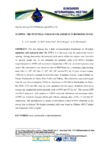Por favor, use este identificador para citar o enlazar este ítem:
http://www.alice.cnptia.embrapa.br/alice/handle/doc/1024348Registro completo de metadatos
| Campo DC | Valor | Lengua/Idioma |
|---|---|---|
| dc.contributor.author | ANTOLIN, L. A. S. | pt_BR |
| dc.contributor.author | COSTA NETO, G. M. F. | pt_BR |
| dc.contributor.author | BORGES, M. G. | pt_BR |
| dc.contributor.author | HEINEMANN, A. B. | pt_BR |
| dc.date.accessioned | 2015-09-18T11:11:11Z | pt_BR |
| dc.date.available | 2015-09-18T11:11:11Z | pt_BR |
| dc.date.created | 2015-09-18 | pt_BR |
| dc.date.issued | 2015 | pt_BR |
| dc.identifier.citation | In: INOVAGRI INTERNATIONAL MEETING, 3., 2015, Fortaleza. Anais... Fortaleza: INI, 2015. | pt_BR |
| dc.identifier.uri | http://www.alice.cnptia.embrapa.br/alice/handle/doc/1024348 | pt_BR |
| dc.description | The rice farming has a high socioeconomical importance for Brazilian population, and represents since the 1970?s, it is the main crop for agricultural borders opening. Aiming characterize the potential yield and to define the regions most favorable for growth upland rice, it was simulated the potential grain yield (PGY), potential evapotranspiration (ETP) and maximum transpiration (TRC) by anoriented process crop model. The simulations were based on cultivar BRSPrimavera, considering eight planting dates (Nov 1st, 10th, 20th, Dec 1st, 10th, 20th, 30th and Jan 9th), for 33 years of data weather (1980-2013), in seven locations at Rondônia state: Ariquemes, Cacoal, Guajara-Mirim, Ji-Paraná, Machadinho do Oeste, Porto Velho and Vilhena. The upland rice crop cycle ranged from 95 days from emergence (DAE) in Ariquemes to 99 DAE in Machadinho do Oeste. The PGY, ETP and TRC data set were spatialized for the region. Rondônia showed an average and standard deviation potential yield of 4393 and 477 kg ha-1. The average ETP was 584,8 mm/cycle, with variance of 1259.9 mm/cycle. Maximum and minimum values of ETP was found for Guajara-Mirim and Vilhena, planting dates of Nov 1st and Jan 9th, respectively. The spatialization of results demonstrated a trend of PGY reduction as the sowing date is delayed. The highest potential yield were found at Vilhena (4952.7 kg/ha) and Ariquemes (4461.4 kg/ha). | pt_BR |
| dc.language.iso | eng | eng |
| dc.rights | openAccess | eng |
| dc.subject | Rondonia | pt_BR |
| dc.title | Mapping the potential yield of upland rice in Rondonia State. | pt_BR |
| dc.type | Artigo em anais e proceedings | pt_BR |
| dc.date.updated | 2016-03-22T11:11:11Z | pt_BR |
| dc.subject.thesagro | Arroz | pt_BR |
| dc.subject.thesagro | Oryza sativa | pt_BR |
| dc.subject.thesagro | Evapotranspiração | pt_BR |
| dc.subject.thesagro | Produtividade | pt_BR |
| riaa.ainfo.id | 1024348 | pt_BR |
| riaa.ainfo.lastupdate | 2016-03-22 | pt_BR |
| dc.identifier.doi | http://dx.doi.org/10.12702/iii.inovagri.2015-a112 | pt_BR |
| dc.contributor.institution | LUIS ALBERTO S. ANTOLIN, graduando UFG; GERMANO MARTINS F. COSTA NETO, mestrando UFG; M. G. BORGES; ALEXANDRE BRYAN HEINEMANN, CNPAF. | pt_BR |
| Aparece en las colecciones: | Artigo em anais de congresso (CNPAF)  | |
Ficheros en este ítem:
| Fichero | Descripción | Tamaño | Formato | |
|---|---|---|---|---|
| Inovagri.pdf | 617,91 kB | Adobe PDF |  Visualizar/Abrir |









